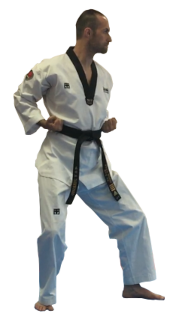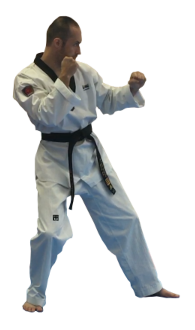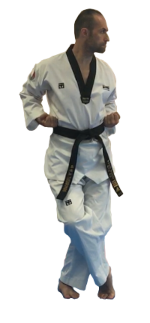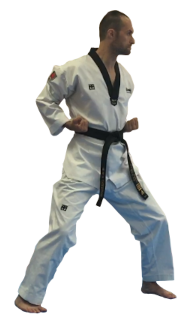Stances
Seogi Kisul - 서기 기술
What Is A Stance?
When looking at how we apply stances in “traditional” martial arts it is important to understand that they are not intended to be a static or fixed position, rather, they represent the position one’s body is in at the moment of a shift in weight during a defensive or offensive motion. We do not fight from a Forward Stance, but we do use a Forward Stance when we fight. Think of each stance as a snap shot in time. Stances are the key foundational skill upon which all other martial arts skills find utility or a lack thereof.
Stance Accuracy In Poomsae
Stance measurements are a threshold guide and not meant to be exact, you should go by what feels more natural to your body – 2 steps long vs approximately 2 steps long, for example. That being said being too far outside of the described length, width or weight distribution of a stance will result in a minor or major deduction, depending on the severity of the inaccuracy.
Stances have only two possible hip heights: Upper and Lower. Hips should be at the same height for all Lower Stances, for example, a Crane Stance / Hakdari Seogi and a Forward Stance / Ap Gubi will have the hips at the same level.
The Upper/Lower list below refers only to stances which appear in Recognized Poomsae (official colour belt and black belt forms).
-
Closed Stance / Moa Seogi
Parallel Stance / Naranhi Seogi
Walking Stance / Ap Seogi
Side Stance / Yeop Seogi
-
Riding Stance / Juchum Seogi
Forward Stance / Ap Gubi
Backward Stance / Dwit Gubi
Tiger Stance / Beom Seogi
Front Cross Stance / Ap Kkoa Seogi
Back Cross Stance / Dwi Kkoa Seogi
Crane Stance / Hakdari Seogi
Reverse Crane Stance / Ogeum Seogi
Angled Forward Stance / Mo Ap Gubi
Assisting Stance /Gyeotdari Seogi
Closed Stance
Moa Seogi
모아 서기
“Moh-Ah Suh-Gee”
Height: Upper Stance
Poomsae: A stance with the inside edges of both feet completely closed together and both knees straight.
Practical Application: Used to develop the ability to relay powerful arm strikes and defensive movements without relying entirely on the force one can generate from a wider and longer base such as an Angled Riding Stance or Forward Stance.
Parallel Stance
Naranhi Seogi
나란히 서기
“Nah-Rahn-Hee Suh-Gee”
Height: Upper Stance
Width: 1 foot length
Poomsae: The feet are parallel and each leg supports an equal amount of weight.
Practical Application: Used to develop the ability to relay powerful arm strikes and defensive movements without relying entirely on the force one can generate from a wider and longer base such as an Angled Riding Stance or Forward Stance.
Riding Stance
Juchum Seogi
주춤 서기
“Joo-Choom Suh-Gee”
Height: Lower Stance
Width/Length: Approximately 2.5 foot lengths
Poomsae: Also called Horse Riding Stance. The feet are parallel and each leg supports an equal amount of weight, knees are slightly bent.
Practical Application: An equal amount of body weight loaded over each knee makes the Riding Stance great for actual fighting, typically in the form of an Angled Riding Stance / Mo Juchum Seogi. When used stationary and practicing poomsae style techniques it can help with the development of the quadriceps muscles.
The older style wider and lower Horse Riding Stance can be called 낮추어 서기 Najchueo Seogi ('“Nahj-Choo-Uh Suh-Gee”) / Low Stance.
Forward Stance
Ap Gubi
앞 굽이
“Ahp Goob-Ee”
Height: Lower Stance
Length: Approximately 2.5 - 3 foot lengths
Width: Approximately 1 foot width
Poomsae: Also called Front Stance or Long Stance. The front foot points forward at 0°, the rear foot and torso are pivoted out at approximately 30°, the forward leg supports two-thirds of the body’s weight.
Practical Application: Using the legs to generate explosive forward force in order to cover distance while delivering a strike with the hands or elbows, or prior to delivering a kick. We do not fight from a Forward Stance but we use a Forward Stance while fighting.
Walking Stance
Ap Seogi
앞 서기
“Ahp Suh-Gee”
Height: Upper Stance
Length: Approximately 1 foot length
Width: Approximately 1 foot width
Poomsae: Also called Short Stance. The front foot points forward at 0°, the rear foot and torso are pivoted out at approximately 30°, each leg supports an equal amount of weight.
Practical Application: Used to develop the ability to relay powerful arm strikes and defensive movements without relying entirely on the force one can generate from a wider and longer base such as an Angled Riding Stance or Forward Stance.
Backward Stance
Dwit Gubi
뒷 굽이
“Dweet Goob-Ee”
Height: Lower Stance
Length: Approximately 2 foot lengths
Width: Front heel overlaps the rear heel if the feet are drawn together
Poomsae: Also called Back Stance. The feet make a 90° angle and the rear leg supports two-thirds of the body’s weight by bending the knee to approximately 100° - 110°.
Practical Application: Used to quickly move the head and torso out of range of an attack by loading weight onto the rear leg, usually paired with a backward step of the rear foot. Also makes for quicker kicking attacks off of the front foot. We do not fight from a Backward Stance but we use a Backward Stance while fighting.
Tiger Stance
Beom Seogi
범 서기
“Buhm Suh-Gee”
Height: Lower Stance
Length: Forward foot heel aligned with rear foot’s toes
Width: Approximately 1 foot width
Poomsae: The front foot points forward at 0°, the rear foot and torso are pivoted out at approximately 30°, the rear leg supports the majority of the body’s weight while the forward foot is lightly touching the floor with the heel completely raised.
Practical Application: When used defensively one can quickly take weight off of the forward leg when blocking a low kicking attack isn’t possible, lessening the damage of the blow. When used offensively one can deliver speedy kicks with the front leg.
Front Cross Stance
Ap Kkoa Seogi
앞 꼬아 서기
“Ahp Koh-Ah Suh-Gee”
Height: Lower Stance
Width: Approximately 1 foot width
Poomsae: The calf muscle of the forward leg is in contact with the shin of the rear leg, the heel of the forward foot is raised with the heel of the rear foot being planted. Both legs support an equal amount of weight.
Practical Application: Used as a quick crossing step on the spot prior to delivering a Turn Kick / Dollyeo Chagi. Can serve to freeze the opponent in place from the quick movement as well as add more power to a front leg attack. The cross step can be paired with a feint of the upper body to further mask the kick.
Back Cross Stance
Dwi Kkoa Seogi
뒤 꼬아 서기
“Dwee Koh-Ah Suh-Gee”
Height: Lower Stance
Width: Approximately 1 foot width
Poomsae: The shin of the rear leg is in contact with the calf muscle of the forward leg, the heel of the rear foot is raised with the heel of the front foot being planted. The torso and front foot may be angled at 30° inward or outward depending on the situation. Both legs support an equal amount of weight.
Practical Application: Can be used to quickly cover distance to an opponent before planting the anchor foot on the floor and delivering a powerful kicking technique such as the Side Kick / Yeop Chagi. Similar to the Fast Kick / Ppaleun Bal Chagi but is typically a little slower.
Left Side Stance
Oen Yeop Seogi
왼 옆 서기
“Wayn Yuhp Suh-Gee”
Right Side Stance
Oreun Yeop Seogi
오른 옆 서기
“Oh-Roon Yuhp Suh-Gee”
Height: Upper Stance
Length: 1 foot length
Width: Front heel overlaps the rear heel if the feet are drawn together
Poomsae: Also called Left Stance/Right Stance. The feet make a 90° angle and each leg supports an equal amount of weight.
Practical Application: Used to develop the ability to relay powerful arm strikes and defensive movements without relying entirely on the force one can generate from a wider and longer base such as an Angled Riding Stance or Forward Stance.
Crane Stance
Hakdari Seogi
학다리 서기
“Hahk-Dah-Lee Suh-Gee”
Height: Lower Stance
Poomsae: A stance of lowering one knee, while lifting up the other foot to place its inside edge near the inside edge of the knee.
Practical Application: Defensively it uses the shin bone to block kicks to the leg while offensively it can be used to draw the front foot away from an opponent before delivering a Side Kick / Yeop Chagi.
Reverse Crane Stance
Ogeum Hakdari Seogi
오금 학다리 서기
“Oh-Goom Hahk-Dah-Lee Suh-Gee”
Height: Lower Stance
Poomsae: The same as in Crane Stance except that the raised foot is placed behind the knee of the support leg.
Practical Application: Defensively it can pull the leg back to evade or block with the knee against kicks to the leg while offensively it can be used to draw the front foot away from an opponent before delivering a Side Kick / Yeop Chagi.
“Ogeum” refers to the back of the knee, where allegedly all blood vessels, nerves, and lymphatic vessels distributed to the legs and feet pass through.
Angled Riding Stance
Mo Juchum Seogi
모 주춤 서기
“Moh Joo-Choom Suh-Gee”
Height: Lower Stance
Width: Approximately 2.5 foot lengths
Poomsae: The feet are parallel and each leg supports an equal amount of weight, knees are slightly bent. Does not appear in any recognized poomsae.
Practical Application: Typically adopted in Kyeorumsae / Fighting Stance due to its balanced ability to move in all directions and relay all tools without any sort of preparatory movement first.
Angled Forward Stance
Mo Ap Gubi
모 앞 굽이
“Moh Ahp Goo-Bee”
Height: Lower Stance
Length: Approximately 2.5 - 3 foot lengths
Width: 0 (both feet occupy the same lane)
Poomsae: Both feet are pivoted out at approximately 30°, the rear leg supports two-thirds of the body’s weight while looking in the direction of the straight leg rather than the bent one. Appears in the poomsae Taegeuk Pal-Jang (8) and Hansu. Sometimes referred to as “Diamond Stance”.
Practical Application: Offensively: The front foot steps forward and to the side of the center line while delivering a strike. Defensively: An elongated version of the Backward Stance / Dwit Gubi which takes the head further from the opponent but results in slower counter attack possibilities due to the distance covered.
Forward Riding Stance
Ap Juchum Seogi
앞 주춤 서기
“Ahp Joo-Choom Suh-Gee”
Height: Lower Stance
Length: Approximately 3 foot lengths
Width: Approximately 1 foot width
Poomsae: As in Walking Stance, the front foot points forward at 0°, the rear foot and torso are pivoted out at approximately 30°, each leg supports an equal amount of weight however the knees are bent similar to Riding Stance. The rear foot’s heel is raised. Does not appear in any recognized poomsae.
Practical Application: A stance typically moved in to and out of in Olympic style kyorugi to add to the dynamic nature of one’s footwork.
Assisting Stance
Gyeotdari Seogi
곁다리 서기
“Gyuht-Dah-Lee Suh-Gee”
Height: Lower Stance
Poomsae: A posture of bending the legs by moving the center of gravity on one foot and keeping the center of balance with the assistance of the other foot. The big toe of the assisting rear foot should be half way up the length of the forward foot. The assisting foot makes a Pulled Foot shape just like in Tiger Stance / Beom Seogi.
Practical application: Used to deliver a rear arm striking technique from out of range by taking a Trigger Step forward with the rear foot, thereby bringing the rear shoulder closer to the target.
“Gyeotdari” refers to the legs being side by side.
Sparring Stance
Gyeorugi Junbi Seogi
겨루기 준비 서기
“Gyuh-Roo-Gee Joon-Bee Suh-Gee”
The posture taken prior to engaging in Olympic Sparring practice or competition.
Generally the fighter will stand completely sideways to the opponent with the arms held in Middle Guard, Low Guard or No Guard.
Fighting Stance
Hoshin Junbi Seogi
호신 준비 서기
“Hoh-Sheen Joon-Bee Suh-Gee”
The posture taken prior to engaging in Open Sparring practice or competition.
Generally the fighter will stand with their body oriented at 45 relative to the opponent with the arms held in High Guard, Middle Guard or Low Guard.
Breaking Stance
Gyeogpa Junbi Seogi
격파 준비 서기
“Gyuhg-Pah Joon-Bee Suh-Gee”
The posture taken prior to engaging in Breaking practice or competition.
Uncommon Stances
This is a list of stances which exist but don’t show up in any Recognized Poomsae and are more or less relics of the early “Korean Karate” days of Taekwondo but are worth looking at for educational purposes.
Open Stance
Neolphyeo Seogi
넓혀 서기
“Nuhlp-Hyuh Suh-Gee”
A classification for any stance where there is space between the feet, such as Naranhi Seogi or Juchum Seogi.
At Ease Stance
Pyeonhi Seogi
변히 서기
“Pyuhn-Hee Suh-Gee”
Standing in Naranhi Seogi / Parallel Stance with the feet turned outward by 60°.
Inward Stance
Anjjong Seogi
안쫑 서기
“Ahn-Chjohng Suh-Gee”
Standing in Naranhi Seogi / Parallel Stance with the feet turned inward by 60°.
Angled Stance
Mo Seogi
모 서기
“Moh Suh-Gee”
Standing in Naranhi Seogi / Parallel Stance with the feet turned 45° in the same direction.
Inward Riding Stance
Anjjong Juchum Seogi
안쫑 주춤 서기
“Ahn-Chjohng Suh-Gee”
Standing in Juchum Seogi / Riding Stance with the feet turned inward by 60°.
T-Shaped Stance / O-Shaped Stance
O-Ja Seogi
”ㅗ”자 서기
“Oh-Jah Suh-Gee”
Standing in Dwit Gubi / Backward Stance with the front foot lined up with the middle of the back foot, making the shape of the Hangul vowel ㅗ which makes the sound “o”, though you can also use the letter T from the alphabet when naming it.
L-Shaped Stance / N-Shaped Stance
Nieun-Ja Seogi
”ㄴ”자 서기
“Nee-Oon-Jah Suh-Gee”
Standing in Dwit Gubi / Backward Stance the heels touching, making the shape of the Hangul consonant ㄴ (Nieun 니은) which makes the sound “n”, though you can also use the letter L from the alphabet when naming it.
This stance appears in Cheonkwon Poomsae during the Jajeun Bal Ditgi / Rapid Stepping section.
Small Forward Stance
Jageun Ap Gubi
작은 앞 굽이
“Jahg-Oon Ahp Goob-Ee”
A Forward Stance which is smaller than a standard one by about one step.
Appears only in Cheonkwon Poomsae.
Attention Stance
Dwichuk Moa Seogi
뒤축 모아 서기
“Dwee-Choog Moh-Ah Suh-Gee”
Standing in Moa Seogi / Closed Stance with the toes turned outward by 60°.
Reverse Attention Stance
Apchuk Moa Seogi
앞축 모아 서기
“Ahp-Choog Moh-Ah Suh-Gee”
Standing in Moa Seogi / Closed Stance with the heels turned outward by 60°.



























